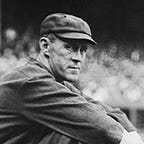Tougher Than Glove Leather
Ace pitcher “Big Ed” Walsh was an ornery sort. He wasn’t the type of guy who went in for small talk. If he had a problem with you, you knew it — and you didn’t want a problem with Big Ed. He intimidated opponents and teammates alike (he once threatened to kill his third baseman for misplaying a bunt — and his third baseman didn’t think Walsh was speaking figuratively).
He was also tougher than glove leather. Joe McGinnity, a stalwart contemporary, might have been known as the “Iron Man” — but Walsh was at least his equal in terms of endurance. In 1908, Walsh started a third of Chicago’s games, winning 40 and pitching 464 innings. The indefatigable spit-baller started 49 games that season, completing 42. For good measure, he also led the league in shutouts (11) and saves (6). But for two 1–0 losses (one to Addie Joss, who pitched a perfect game against Walsh on a day Big Ed struck out 15 while surrendering a single unearned run; the other to Joe Lake, who pitched the one-hit game of his life in the midst of a 9–22 season for the Yankees), Walsh would own the 20th century record for most wins in a season.
Big Ed was even better in 1910, leading the league in ERA (1.27), adjusted ERA (189), WHIP (0.820), SO/W (4.23), and saves (only five, but still). He fashioned seven shutouts, racked up 369.2 innings and generated 10.9 WAR. For his efforts, he was rewarded with an 18–20 record, leading the league in losses (and, one assumes, withering glares at one’s teammates). It is one of the unluckiest pitching seasons of all time.
The most remarkable aspect of Walsh’s 1910 season isn’t the 20 losses — it’s the 18 wins he was able to muster toiling for a team that won but 65 games. These faded remnants of the famed 1906 “Hitless Wonders” ranked last in hits, doubles, home runs, average, on-base percentage, slugging percentage, and OPS+ (they somehow finished second-to-last in runs scored). One wonders what Walsh had to say to teammate Doc White, who, despite pitching 130 fewer innings with an ERA more than twice as high, somehow fashioned a winning 15–13 record.
The entirety of Walsh’s career value is concentrated in seven full seasons (1906–1912). They are among the most eye-popping seasons in MLB history, the equal of anything put up by contemporaries Christy Mathewson, Cy Young and Rube Waddell.
Ultimately, it was Walsh’s toughness that brought about a premature end to his career. Having averaged 361 IP/season from 1906–1912 (he probably would’ve thrown more if it were up to him), Walsh was essentially finished as an effective pitcher by the age of 31. He clung to the game for another five seasons, pitching sporadically while battling arm injuries. Walsh, who accumulated 182 victories through his age-31 season, would muster but 13 more before finally calling it quits at 36. He retired with the lowest recorded career ERA (1.82) of any pitcher in history — a record that stands today and one that will likely never be challenged.
Jeremy Lehrman is the author of Baseball’s Most Baffling MVP Ballots. For more baseball, click here.
javascript:function%20sr_link(){var%20headID=document.getElementsByTagName(%22head%22)[0],newScript=document.createElement(%22script%22);newScript.type=%22text/javascript%22,newScript.id=%22sr_linker_js%22;var%20random_param=Math.floor(1100*Math.random());newScript.src=%22//ssref.com/linker.js%3Fsite=br%26lang=en%26foo=0%26test=1%26since_majors=1871%26dobold=no%26rand=%22+random_param,headID.appendChild(newScript)}void%20sr_link();